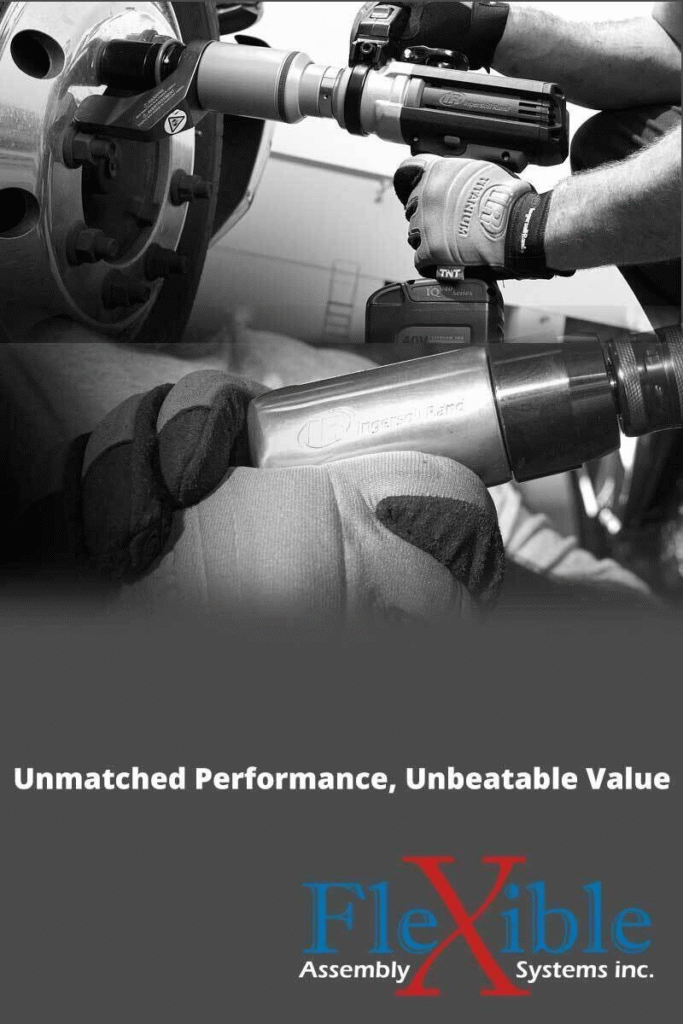
High-volume assembly lines face two common foes: torque swings and part shortages. A single over-torqued joint can mean scrap or recall. A missing fastener can halt the line. Torque arms stop spin forces at the source. Screw feeders hand you each fastener on cue. When you pair them, you cut waste, boost pace, and ease operator strain.
This article covers each tool. You will learn how a torque arm locks reaction forces. You will see how a screw feeder delivers a steady stream of parts. You will get steps to build one smooth work cell. You will find real-shop scenarios that show gains in time and quality. Finally, you will see Why Choose Flexible Assembly Systems for design, install, and support.
Role of Torque Arms in High-Volume Assembly
A powered driver spins a fastener into place. Every twist pushes back against your hand. Without a reaction path, the tool will torque your wrist instead of the screw. A torque arm steps in as a fixed counterforce. It passes spin force to a mount, not your body.
Mechanics of a Torque Arm
- A rigid mount attaches to bench, floor, or overhead beam
- A swivel joint links mount and arm, allowing one-plane motion
- An adapter on the end grips the driver shaft
- Torque travels down the arm into mount, not into your wrist
You hold just enough force to guide the tool. The arm absorbs all spin-back.
Value for Your Line
- Cut scrap by holding each fastener within spec
- Reduce operator fatigue so each shift stays sharp
- Extend tool life by removing shock loads
- Speed up audits with torque logs at the mount
- Boost safety through controlled reaction transfer
A plastic parts line in Ohio saw joint rejects drop by 60% after one week with torque arms in place. Operators reported no wrist pain by day’s end.
Role of Screw Feeders in Fast, Large Runs
Hand-feed work stalls pace and invites error. Screw feeders sort, orient, and present parts at tool level. You grab, drive, repeat. No search time. No drop.
Mechanics of a Screw Feeder
- A vibratory bowl or centrifugal track moves parts onto a raceway
- Guide rails orient each fastener head-first
- A chute or track holds one part at pickup point
- A sensor confirms part presence before the driver fires
You adjust feed rate via control box. That lets you match any takt time from 200 to 600 units per minute.
Value for Your Line
- Eliminate search time so operators focus on drive cycles
- Match feed speed to takt rate for uniform pace
- Cut misfeeds through positive part confirmation
- Track run counts per station for traceability
- Swap bowls or tracks fast to handle part changes
An electronics assembler in Texas hit 350 units per hour—70 more than before. Part errors fell by 80%.
Integrate Torque Arms and Feeders for Smooth Flow
Pair these devices to build one linked cell. A torque arm holds the driver steady. A feeder hands each screw to the tool. You avoid both spin shocks and delays between cycles.
Cell Setup Steps
- Mount arm so driver rests at neutral point when idle.
- Position feeder chute within 10 cm of tool nose.
- Route power and signal cables away from moving joints.
- Set slip clutch at desired torque on arm mount.
- Tune feeder rate to match average drive time.
A simple relay or PLC can link the two. The feeder only runs when the tool returns to idle.
Data and Control
- Use torque sensor at arm mount to log each turn
- Use part-present sensor at chute to log each feed
- Feed both data streams into a line controller or cloud
You spot drift before it costs a shift. You spot fastener jams before they halt output.
Why Choose Flexible Assembly Systems
You need gear that fits your parts, drives, and pace. Flexible Assembly Systems builds each solution to order.
- Expert fit: We match arm length and torque range to your drivers.
- Bowl or track choice: We select the feeder style to suit your fastener shape.
- Turnkey install: We mount devices, route cables, and run pilot parts.
- Remote link: We stream torque and feed data back to our support desk.
- Quick training: We run short sessions so your team masters basic tune-ups.
When you work with us you get a partner who keeps your line tight day after day.
Best Practices for Long-Term Flow
Small checks avoid big slowdowns. Adopt these steps as standard:
- Tighten mount bolts on torque arms each four weeks
- Wipe down bowl interior and track daily to prevent jams
- Verify torque set point after any driver swap or service
- Label each feeder bowl with part number and speed setting
- Keep spare adapters on hand for quick tool changes
- Archive torque and feed logs; review weekly for trends
This routine guards your output and your quality record.
Examples from Real Workshops
Here are three shop-floor runs that show real improvements.
Automotive Components Plant, Michigan
A plant built valve bodies that needed 16 fasteners each. Operators hit only 75% of daily targets. They added torque arms at every station. They also fit feeders for M6 bolts. Result: output rose 28%. Scrap fell by 50%. Workers cut wrist injuries in half.
Electronics Contract Manufacturer, Texas
A line assembled control boards with 120 screws per unit. Hand-pick fasteners led to 12% part-missing errors. They installed centrifugal-feeders and torque arms. Line speed climbed by 40%. Errors fell to 1%. The company landed a new high-volume contract.
Medical Device Workshop, California
A team made infusion pumps with nine critical joints each. Inspectors found torque drift after two hours. They fitted torque arms with slip collars. They also added vibratory bowls for tiny screws. Torque stayed within 2% of target for eight hours. Pump quality audits went from 92% to 99.5%.
Final Words
High-volume runs demand firm control and steady part flow. Torque arms absorb spin forces so each joint lands in spec. Screw feeders hand you each fastener at tool level to match any takt. You avoid scrap, delays, and fatigue.
Flexible Assembly Systems brings tailored choice, fast install, and ongoing support under one roof. You gain a work cell that hits quotas day after day. Talk with our experts today. See how torque arms and screw feeders simplify your next line upgrade.


